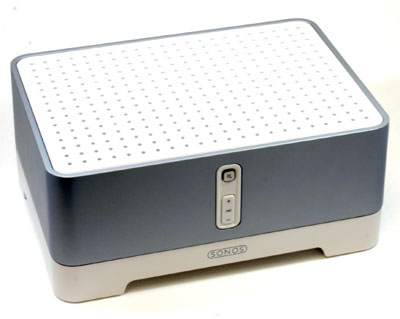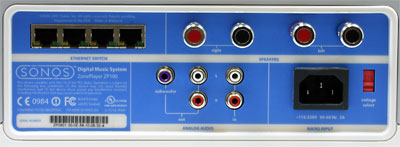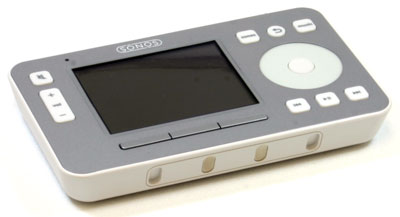Introduction

Sonos ZonePlayer
The Sonos Digital Music System is an interesting combination of a wired/wireless music distribution system, a wireless handheld controller, and a wireless/wired switch, in an easily upgradeable set of basic components. The devices look and feel solid – there’s no cheap, light plastic on the parts that make up this system. The price, at $1199 for two Zone Players and one Sonos Controller, places it in a spot between many competing products. The price may seem high compared to products like the Netgear Wireless Digital Music Player MP101 ($129), the Actiontec Digital Media Player ($180) and similar products from D-Link and SMC. On the other hand, it is low when contrasted to commercial, very-high-end music distribution systems (like those offered by Escient and others) which have prices starting at around $1000 and quickly climbing well into the four figures.
The concept of wireless audio has been around for many years, but has yielded mostly disappointing results. Some early products used infrared (IR) to send the audio signal to wireless headsets or speakers, while others used 900 MHz or 2.4 GHz radio frequencies (RF) to transmit audio (or even video) from unit to unit. The infrared units were line-of-sight, limiting their range and installation options, and the RF units were susceptible to interference from cordless phones and other devices using the same radio frequencies. Neither were serious rivals to wired speakers connected to even a mediocre audio source.
Current wireless distribution products, like those from D-Link, Netgear, SMC and others use 802.11b or g (or 2.4 GHz consumer frequencies). These devices connect to powered speakers, stereo receivers, or TV sets (again, some of these devices can also transfer video). Manufacturers claim high quality audio, and some probably even deliver on that promise, but these devices are all limited by the strength of their wireless signals. The Sonos system uses 802.11g too, but gets around distance limitations in a way to be discussed later.
What It Is
The system we tested consisted of two basic components: the ZonePlayer and the Sonos Controller. Sonos software makes the whole thing work.
The ZonePlayer ZP100 is an interesting device that helps to make a Sonos Digital Network more than just the sum of its parts. The ZonePlayer (I’ll refer to it as the ZP) includes a 50 W amplifier, four-port Ethernet Switch, wired/wireless transmitter/receiver, and ports for connecting speakers, a subwoofer, and external inputs. A set of three buttons controls volume and connections to the Sonosnet network.
The controller includes a rather touchy ‘jog’ bar, volume control buttons, and a color display that enables control of all the ZPs in the network. The controller is rechargeable, so if connected to the charger when not in use, it should be always ready for action. The network can contain as many as 32 ZPs, and up to 16 computers can be used as audio sources.
We received two ZPs, one Sonos Controller, and two pairs of speakers from Sonos. The ZPs included power cords and Ethernet cables. We weren’t quite as fortunate with the speakers – they didn’t come with cables, and we were sent scrambling to find some speaker wire so we could test the system.
Cost
Bundle Price of $1199 which includes two Zone Players and one controller
Additional ZonePlayers – $499
Additional Controllers – $399
Sonos Loudspeakers – $179/pair
The Setup

Back of the ZonePlayer
The Sonos Digital Music System is designed as a wireless/wired hybrid. Unlike other 802.11x media players, which can connect wirelessly to a network, the Sonos system requires that at least one ZP be wired. This is actually a good thing, because the Sonos system uses its own wireless protocols, and provides certain advantages that are beyond what the competition delivers.
We connected one ZP to our network switch. The second ZP was plugged into a power outlet in an office about 50 feet from the first, to be used wirelessly. Once we got speaker wire, the speakers were wired to the ZPs. It should be noted that the ZPs featured large metal attachment points for the speaker wire. Color-coded and substantial, they made connections easy and rock steady. We could have instead used cables with the standard RCA plugs for attaching to the ZP. With the use of a mini-jack to RCA adapter, headphones or computer speakers could also be connected to the ZP, although there might be issues with controlling the amplified output coming from the speakers.
During the course of the review, the wireless ZP was tested in two different offices. The Controller acted something like a bridge, allowing control of both players from anywhere in a test area that was roughly 50 feet wide and multiple walls and doors away from either ZP.
A computer connected to the network served as the media controller, although is not necessary to make the Sonos system work. A notebook computer was used to physically connect to the ‘wireless’ ZP.
Installation And Configuration
The system comes with optional software, called the Sonos Desktop Controller, that can be installed on Windows 2000, XP, and Macintoshes. We had trouble running it on a Windows 2003 Enterprise server, however and did our tests on XP.
You don’t need the software to control your music, although you do need some network storage to contain your files. You can store these files on the same system that run the Sonos controller, or you can save your music on a NAS box or a Linux box as long as the system can see SMB network shares across the network.
Physical installation of the ZP was easy: connect the ZP to power, attach speakers, connect the Ethernet cable included with the ZP to a network switch (at least one ZP has to be connected physically to the network), and then let the software detect the ZP. In order to do this, press the Mute and Volume+ buttons simultaneously. After a few seconds, the ZP is detected.
Each zone must have a unique name. The list of names isn’t especially large, and though the name of each zone can be changed, the process isn’t particularly intuitive. However, if you expect to actually use all 32 zones, you can install a ZP using any of the default names, then change it later. A ZoneManagement screen is used to name or rename zones, and once a name has been changed, the old name is again available.

Additional ZPs can be added in the same way as the first was attached. During our testing, a second, wireless ZP was placed in an office a couple of doorways and about 50 feet away. We told the software to discover the second ZP, but while the computer was waiting for the signal from the second ZP, it was necessary to go over to it. Had this second ZP been upstairs, in the back of the house, detecting it could have been a bit of a hassle.
There are two ways around this mad dash to the ZP. The first is to plug each ZP into the room where the wired ZP is connected to the control computer. That way, they can be connected to the Sonos network, and once connected, easily unplugged and moved to anywhere within radio range. A ZP will continue to connect once it’s been detected by a ZP.
The second way is using the controller. The controller is connected to the network using the same keys. Once the remote is connected, you can go to the installed ZPs and connect them from the rooms where they’ll be used. You can use the handheld controller to test whether or not a signal is received – if the controller can’t get a signal, a ZP in the same area will also be unable to connect.
The Sonosnet Mesh Network
Sonos does wireless a bit differently from your standard 802.11x network, which lets the Sonosnet system overcome some distance limitations. In standard WiFi, there is one centralized access point and range is limited to the distance from it. In the Sonosenet each ZP is, effectively, acting as an access point; signal is bounced from ZP to ZP, creating a ‘mesh’ of radio signals. In theory, if the WiFi signal only carries 75 feet, you can put four ZPs 50 feet apart and, effectively, have a range of up to 225 feet from the first ZP. Each ZP acts as a repeater of sorts, bouncing the signal from one to the next.
We were unable to test the actual distance limit, but as is usually the case “your mileage will vary”, based on the construction of your location, the number of walls the signal must go through, and so on. In principle, the more ZPs you have, the stronger the mesh signals will become. If your goal is distance, multiple ZPs arranged sequentially could distribute a very strong signal over a linear distance many times greater than that supported by standard WiFi.
Although the SONOS transmissions are based on 802.11g protocols, the use of the hardware in a mesh network increases the distance that the network can cover, according to the company. The coding used by Sonos is proprietary, and doesn’t communicate with standard 802.11x. equipment.
Zone Players can be used as network switches – with the four switch ports built into each ZP, their potential use in a network is worth considering. We’ll look at this a bit later in the review.
Media – Stand And Deliver
The Sonos Desktop Controller can get music from as many as 16 different network devices. The setup screen, shown here, clearly displays the options.

In addition to the sources available over a network, Sonos Desktop Controller also comes with a small list of Internet Radio stations. The list was woefully small, but stations can be added by linking to the station you want to add (using your web browser), and copying the address into the Desktop Controller.
The computer that I used to test the Desktop Controller on had no music on it, so I used Microsoft Media Player to rip two CDs. Once the CDs were copied, the Sonos Desktop Controller was able to discover and add the CDs to its playlist.
I started the same tracks from the ripped CDs a few seconds apart on the two ZPs, and the audio quality on both was very good. Similarly, playing two entirely different audio selections worked without any perceptible problems on both ZPs. In addition, I played the same Internet radio stream on the two ZPs, without any quality issues (other than the typical occasional low quality of an Internet radio stream.)
In addition to media on the network and on the local computer, the ZP is capable of playing music from an external source, using a pair of RCA jacks. If you’re looking to play an IPod or walkman over the network, however, you’ll need a 2.5 mm to RCA adapter.
The volume control was smooth, easily modulating from low volume to high and back down again. Additionally, when first starting the Desktop Controller, if you instruct the ZP to start at high volume, the volume will start low and ramp up. We thought this was a useful feature, preventing a loud blast and, potentially, sparing both speakers and eardrums from damage.
Desktop Controller provided a quite useful listing of media activity. With our first zone installed, and a ripped CD playing, the display looked like this:

When the second ZP was added, it was shown on the Zones panel. Selecting the other zones showed what was being played, and provided options for the zone.
The Controller

Sonos Controller
The controller is a nifty color unit that handles many of the same functions as the Desktop Controller. The controller shows the zones available, and allows you to add ZPs to your media network.
This a nice-looking, backlit device. It features built-in batteries, and comes with a charger. We found the ‘trackwheel” a bit of a problem, though. Rather than being an actual wheel, you scroll your finger along a white plastic surface. Although this was really not intuitive, with practice it’s probably adequate.
The controller’s backlight automatically times out if not used. Once a button is pressed, the backlight comes back on.
A “Zone Equalizer,” available on the controller or in the Desktop Controller can equalize volume, balance, bass, and treble. Additionally, a loudness setting (boosting bass at low volumes) can be toggled on and off.

Wireless Possibilities And Testing
Sonos has underplayed some of the capabilities of its product. With a four-port switch on each ZP, the Sonos Mesh Network could, conceivably, become the backbone for a distributed network. Of course, expecting to be able to connect one computer by wire, and 127 wirelessly (4 per ZP x 32 ZPs -1 for the wired port) is asking too much for any wireless network. Still, it may be possible to connect a respectable number of computers wirelessly or, alternatively, connect a percentage of the ZPs to the network using cable, and connect the rest wirelessly.
We tested the wireless communication with our network, and, although we didn’t transfer files across computers in the network, connection to the Internet was fast and problem-free. Files downloaded from the Internet arrived at what appeared to be the speed of the file source. Speed testing indicated network speed of slightly over 900 kB/s.
As a device that can also be used to attach network devices, the system we tested worked fine with one notebook computer connected to the wireless ZP on the network. However, in working with the limited system provided by Sonos, we started feeling like a jockey on a thoroughbred racehorse – stuck on the kiddy track. For the limited amount of testing that was possible with only two Zone Players, there wasn’t really enough to challenge the system.
If budget isn’t an issue, the Sonos Digital Music System could, conceivably, be used to broadcast additional channels of music. For example, the rear speakers for a surround system could use the rear channel output from a surround receiver and broadcast to another ZP in the rear of the viewing room. For small businesses, the system could both carry specific music or announcements aimed at one or more zones, while also providing a wireless network connection to the business workstations.
Conclusion
The Sonos Digital Music System was easy to set up and easy to configure. When coupled with the speakers provided by Sonos, the sound was quite good. A walk down the hall, about 50-75 feet away, and with 3 or 4 intervening walls, still enabled control by the hand held controller.
The system provides a lot of functionality for distributing music to as many as 32 zones. One or all of the Zone Players can be wired into the network. If you need wireless, only one Zone Player has to be physically connected to a network switch and the rest can run wirelessly. Using a proprietary mesh network, the wireless range is greater than basic 802.11b or g. A 50 watt amplifier built into the Zone Player provides adequate power for most users. A subwoofer connection enables use of a subwoofer, and RCA plugs and wireless terminals enable connection to a variety of speaker types.
At $1199 for two Zone Players and a full featured, wireless controller, the Sonos Digital Music System may be a significant step up from low-end digital music distribution systems, while representing a significant savings over products like those from Escient.
